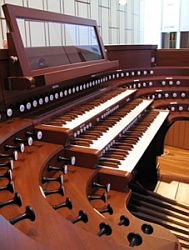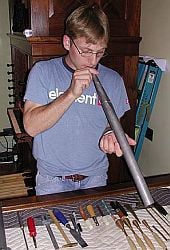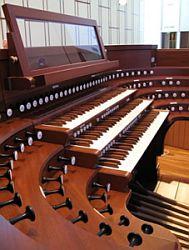The new pipe organ at St. Mark’s Lutheran Church in San Francisco is making itself known among organ aficionados in the Bay Area. Not only is it beautiful to look at, with an outer case and carvings in black walnut, but it has a beautiful sound, as well. It was dedicated on March 25, 2007, and the congregation and concertgoers have spent the past year discovering just what it can do.

“From a pastor’s perspective, it’s thrilling," says the Rev. Elizabeth E. Ekdale. "It’s been a joy to listen to the variety of sounds this organ produces.” The introduction of any great instrument is always a cause for celebration in the music community. But the maiden voyage of this new pipe organ, as well as the recently installed organs at First Congregational Church in Berkeley and First Congregational Church in Palo Alto, are particularly important at a time when, because they’re less expensive and the sound quality has improved significantly, many venues are opting for electronic organs. New pipe organs represent a statement of faith, both in old technology and in the future of music in a 21st-century congregation.
New LeTourneau pipe organ, First Congregational Church, Palo Alto
The pipe organ is more than simply a church instrument. It’s been an important part of the classical music lexicon for centuries. Through the ages, it's served as a marker for sacred rites, from weddings to funerals. Its repertoire includes everything from Bach’s Toccata and Fugue in D Minor to contemporary compositions by Pamela Decker, William Bolcom, and Aaron David Miller.
“The organ has the greatest diversity of repertoire among all the instruments,” says Susan Jane Matthews, director of music at St. Paul’s Episcopal Church in Burlingame and president of the local chapter of the American Guild of Organists. While the organ at St. Mark’s is new, its design is in keeping with the musical tradition of the 17th- and 18th-century organs of the Lutheran Church. The Protestant Reformation led by Martin Luther in 1517 brought with it the development of vernacular hymns, sung by the congregation. Over time the organ began to lead the congregation in these hymns.
By the 17th and 18th centuries, organ music was flourishing, inspiring organ builders in turn to create even more refined and beautiful instruments. The design features on the organ at St. Mark’s that hark back to these organs include mechanical key and stop action found in organs built in the late 1800s, and three bellows that can be inflated by either an electric blower or by foot-pumping. Even the tuning of the St. Mark's organ is a throwback to earlier times. It is tuned in unequal intervals, unlike the equal temperament traditionally used in the last two centuries. George Taylor of Taylor and Boody Organbuilders, the Staunton, Va., firm that built it, says it's “well-suited to the works of J.S. Bach and his contemporaries.” But that doesn’t mean that it’s still not suitable for a wide range of music, as both church services and the ongoing concert series have proven.
The organ's journey to its new home was unusual, to say the least. Taylor and Boody finished building the organ in 2002, but the St. Mark’s seismic retrofitting hadn't yet been completed, and the church wasn't ready for the new instrument. Bad things happen to good organs when they languish in crates, so the ideal solution was to find a place to use the new organ until it could be installed in St. Mark's. A Presbyterian church in Lexington, Va., near Staunton, was awaiting a new organ to replace one lost in a fire. Its new organ would be ready in 2006, when St. Mark’s would be ready for the organ. So it was kept in Virginia during the intervening time, providing music for another church and a suitable temporary home.
Finding the Music
The organ at St. Mark’s Lutheran joins a rich roster of instruments in public locations around the Bay Area (see sidebar below), which are best appreciated at a service or a concert, many of which are free. In addition to the church concerts, many take place in public venues such as Davies Symphony Hall. Sacred music increasingly shares programs with secular and contemporary music, often inspired by new organs built for new symphony halls. The calendar in the monthly newsletter of the San Francisco Chapter of the American Guild of Organists is a great resource. “It can be a treat to delight in the visual feast of watching an organist drawing music out of the king of instruments," says Matthews of St. Paul's Episcopal, but it can also be overwhelming, "perhaps distracting from actually listening to the music."
True to the adage, "the room is the most important stop on an organ," Matthews suggests finding a seat where you may hear the sound of the organ "in the room." This may be loosely compared to standing back a bit to admire a work of fine art. But, she adds, those who wish simply to revel in direct and bold sounds should by all means get right up close to the organ facade, behind which live the pipes.

Every organ’s tone and quality is also affected by how it's built and the building it's built for, says John Karl Hirten, composer, organist, and director of parish music at St. Stephen's Episcopal Church in Belvedere. An organ becomes an integral part of the building in which it resides, and, says Hirten, the organ builder has to take that into account by adjusting the wind pressure and the scaling of the pipes (the ratio of length to width). Stage two of the process, says Hirten, is the voicing, or tuning, of the pipes when the organ is installed. This is done by a specialist, a “voicer," who works with each pipe and regulates the sound by manipulating the size of the "toe" hole, at the bottom of the pipe, as well as touching up the "mouth" of the pipe. It's not so much that the organ itself "settles in" (although there is a little of that), but whether the voicer feels the need to make adjustments.
Ryan Albashian of Taylor and Boody voicing a pipe
Photo by Robbie Lawson
“A good organist always takes the building into account when playing the organ," says Hirten. "A good example is Grace Cathedral. The organ is located in the choir and sounds pretty clear to the audience that sits up there for recitals. However, in the main body of the church — the nave — the organ loses a lot of clarity. Anyone who plays at Grace faces a dilemma of which audience to play for: the ones in the choir, or the ones in the nave.”Ancient King
The organ is arguably the oldest musical instrument still in use today. The first organ was built in ancient Greece. This instrument, called a hydraulis, relied on water pressure to maintain a wind supply and was used at games and in public processions. In the second century, bellows replaced the hydraulic pumps, although there was a brief revival of hydraulic-powered organs at the turn of the 20th century. We know of organs being played in European churches from around the year 900, according to musicologist and SFCV associate editor Michael Zwiebach. He notes that Bach was so enamored of organs that he was always leaving his work, much to the dismay of his employers, so he could test different organs.
The organ, says Zwiebach, continued throughout musical history to play a part in the development of classical styles, and was the unspoken model behind 19th-century orchestration. "Wagner, Schumann, Beethoven, and Richard Strauss all built their orchestration around the blending of textures found in organ music," says Zwiebach. “You’re never really sure what the sound is composed of. It’s the 19th-century equivalent of Dolby Surround Sound.” That the organ can also imitate any number of instruments makes it invaluable to composers and performers.
At the same time, it can create a mix of sound that is unlike any other instrument. The stops, which control the ranks of pipes, let the organist influence tonal quality and pitch to add color and brightness to the piece. Pedals, in addition to the keyboards, allow an organist to add chords and runs; there's even some organ music written exclusively for the foot pedals. A note played on the organ is sustained until the key is released, which allows a flexibility in holding notes and creating an effect that is not available to a pianist. Organs also come in a range of sizes, which allows even more options for shaping the music. Even a relatively small organ, such as that at St. Stephen’s in Belvedere, has 30 ranks or rows of pipes; the organ at Grace Cathedral has 125 ranks of pipes. And organs can be even bigger; the largest playable organ, the Wanamaker Organ at what is now Macy’s department store in Philadelphia, has six keyboards and more than 450 ranks of pipes.
A Look at the Best
What makes an organ special, though, is its individual sound, and that’s harder to quantify by simply mentioning size or location. As Hirten says, “It needs to sing.” Choosing the best is always open to personal interpretation, but organists Hirten, Matthews, Jonathan Dimmock of St. Ignatius Church in San Francisco, Larry Marietta of First Congregational Church in Berkeley, as well as Michael Zwiebach, have named 11 favorites.The Best Organs of the Bay Area
San Francisco
Grace Cathedral Palace of the Legion of Honor St. Luke's Episcopal Church Trinity Episcopal ChurchEast Bay
First Congregational Church, Berkeley First Presbyterian Church, Oakland St. John's Presbyterian Church, Berkeley St. Mark's Episcopal Church, Berkeley Holtkamp Organ, Hertz Hall, UC BerkeleyMarin
St. Stephen's Church, BelvederePeninsula
Stanford Memorial Church
Grace Cathedral’s Alexander Memorial Organ makes all the lists. Built by the Aeolian-Skinner Organ Company of Boston and given to the Cathedral in 1934, it's considered one of the finest examples of an American classic instrument in the country. Other great organs in San Francisco include the aforementioned Taylor and Boody organ, at St. Mark’s Lutheran Church, which is already making a name for itself among local organists. A lesser-known gem is the E.M. Skinner organ at Trinity Episcopal Church. It was built in 1924, when Skinner is considered to have built his finest organs, and is in its original state. Another well-regarded instrument, built by Aeolian-Skinner in 1960, is at St. Luke’s Episcopal Church.
And several organ experts SFCV consulted mentioned the Palace of the Legion of Honor's 1924 Skinner Organ, whose 4,500 pipes sound particularly clearly throughout the museum (while not necessarily so well in the concert hall itself), thanks to the unique canvas apse in the Rodin Gallery, painted in trompe l'oeil style to look like marble.In the East Bay, the First Congregational Church in Berkeley has just installed a new organ, built by Petty-Madden. The organ seems to suit French composers like César Franck and Maurice Duruflé. Two other Berkeley churches also boast fine instruments and frequent concerts. St. Mark’s Episcopal Church installed a tracker organ, in which all the mechanisms are mechanical rather than electric, built by D.A. Flentrop in 1971 and expanded in 2002. St. John’s Presbyterian Church also has a fine tracker organ, built by John Brombaugh.
The Holtkamp Organ at Hertz Hall in UC Berkeley, and in Oakland, the Rosales Organ at the First Presbyterian Church of Oakland, also win praise.In the North Bay, Hirten has a fondness for the organ he plays at St. Stephen’s in Belvedere. And on the Peninsula, Stanford University's Memorial Church has a trio of organs, housed in a sanctuary with a reputation for lively acoustics. The oldest, the Murray Harris organ, installed in 1901 and thoroughly restored in 1996, is especially suited for pieces from the Romantic period. The second installed was the Fisk-Nanny Organ, constructed by Charles Fisk, in 1984. Built to showcase Baroque music, it was a labor of love, taking nearly 30 years to complete.
Finally, the Katherine Potter-Brinegar Organ, built by Paul Fritts and Company, is a single-manual (keyboard) organ that replicates the German chamber organ built for secular music in 1610 by Esias Compenius. As these examples show, the Bay Area is truly blessed with a wealth of grand organs that raise the rafters in churches and halls, and thrill those who love the mighty instrument.

